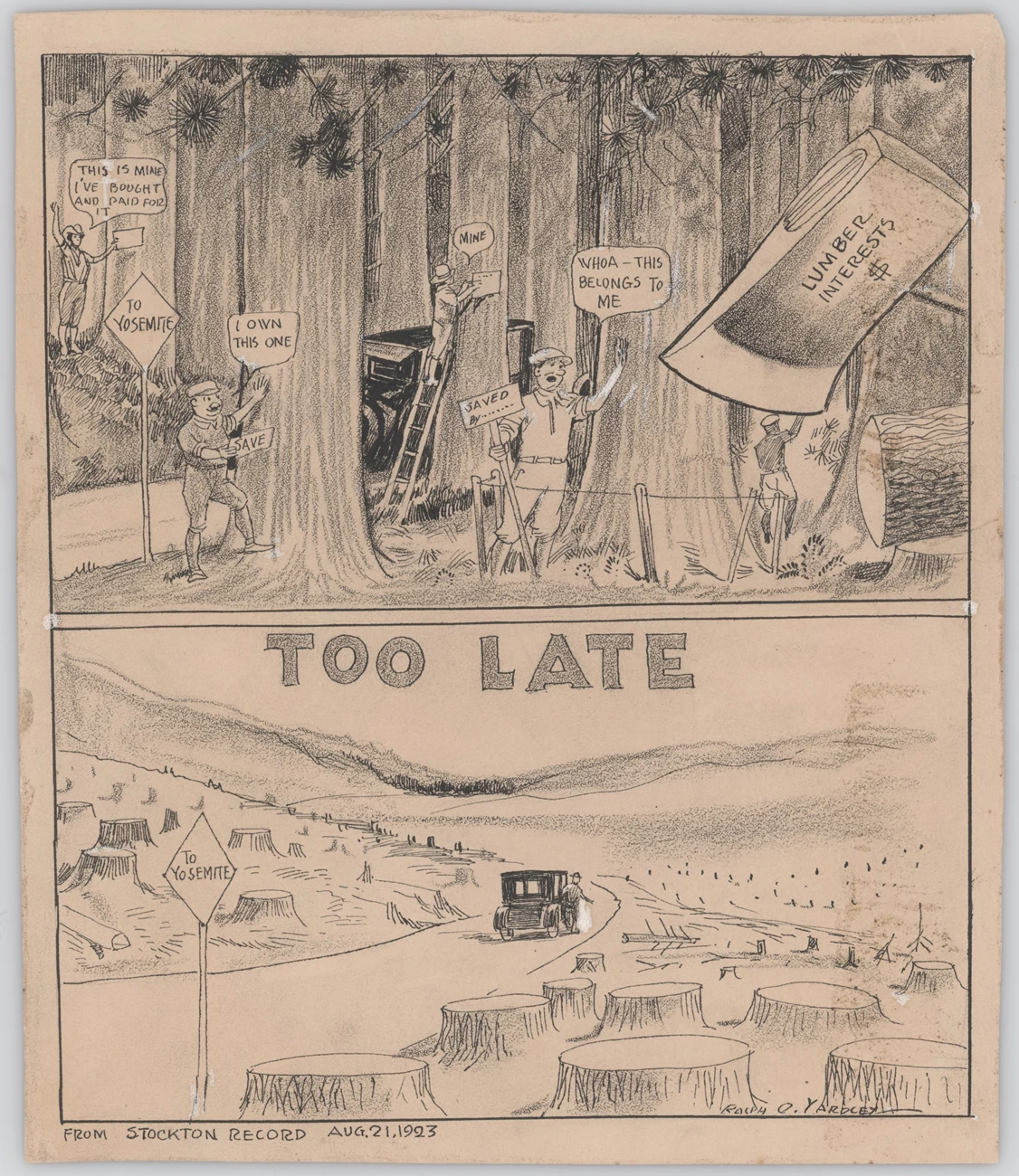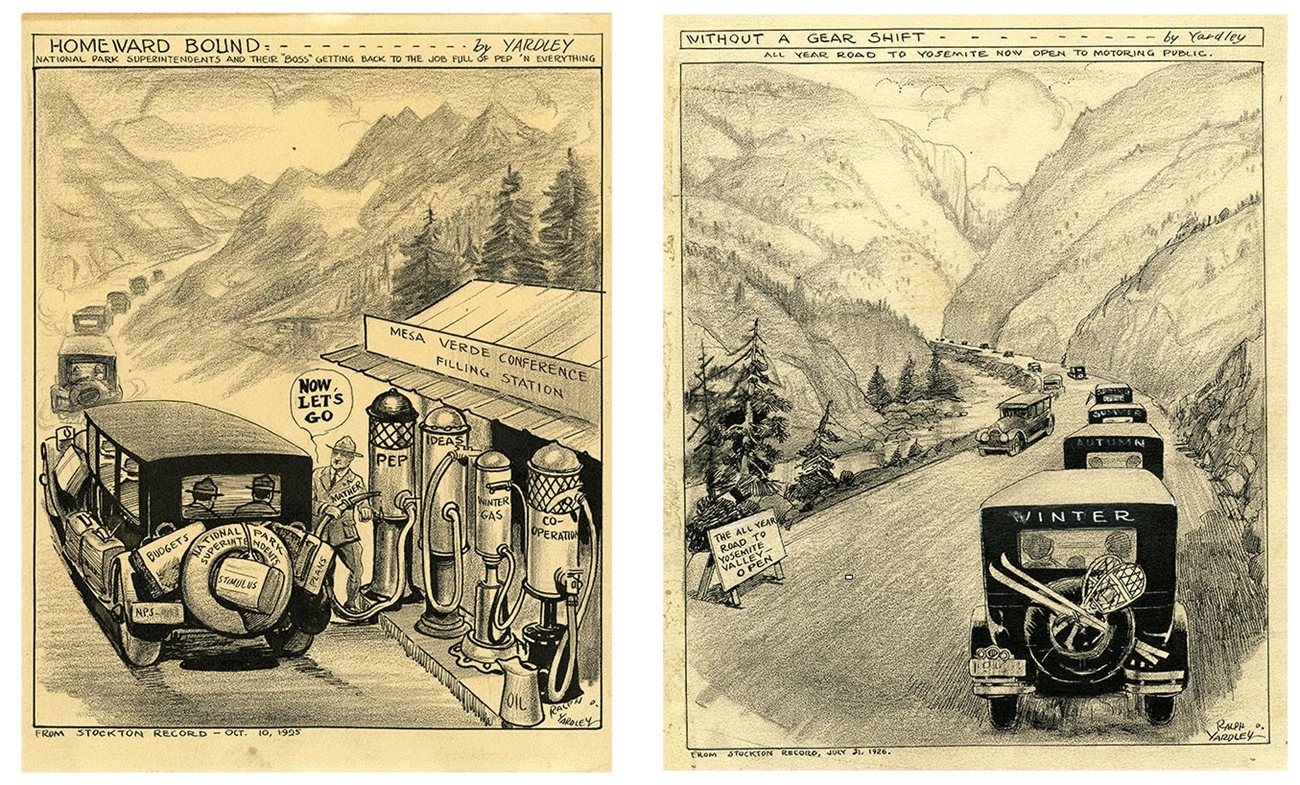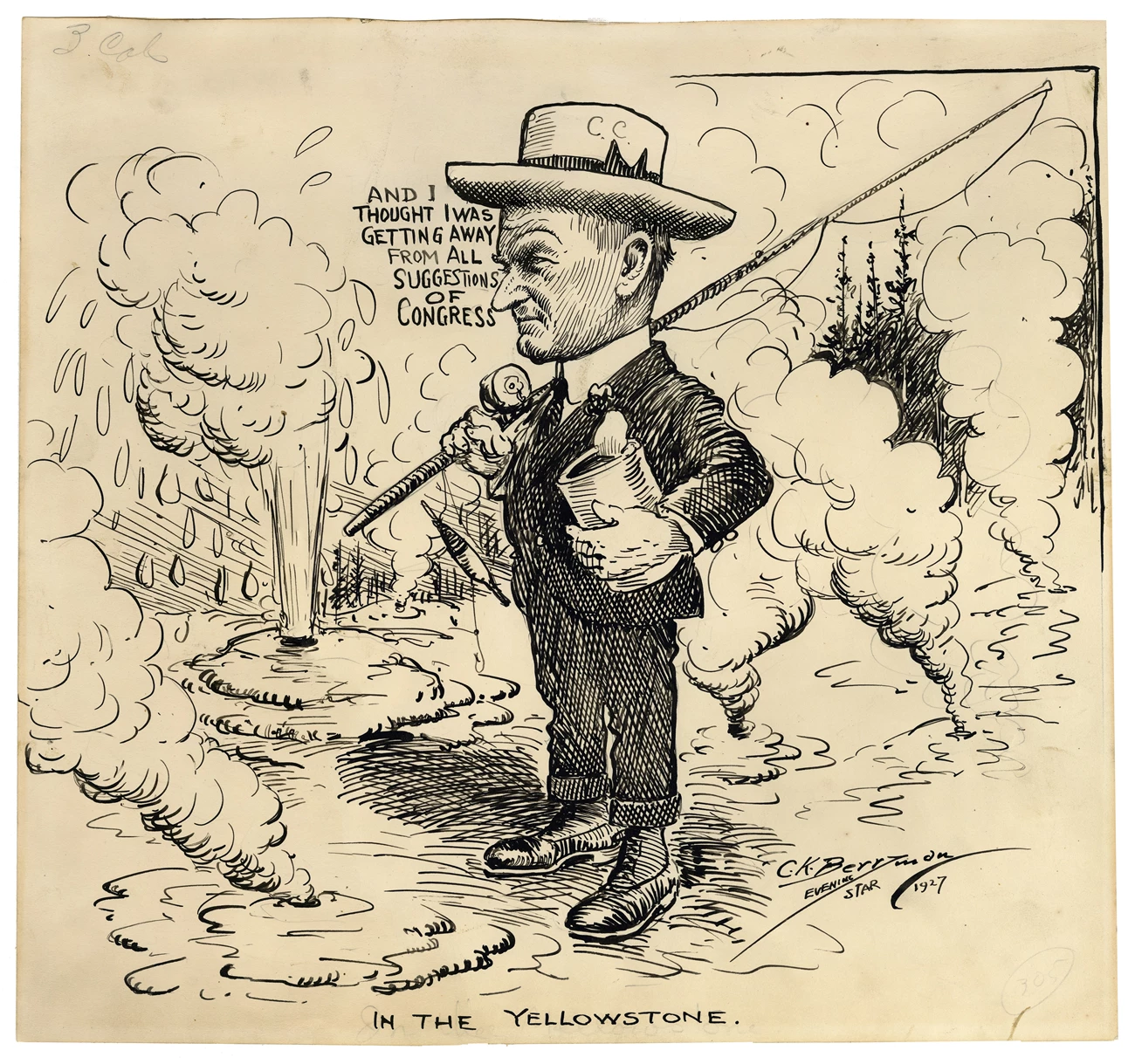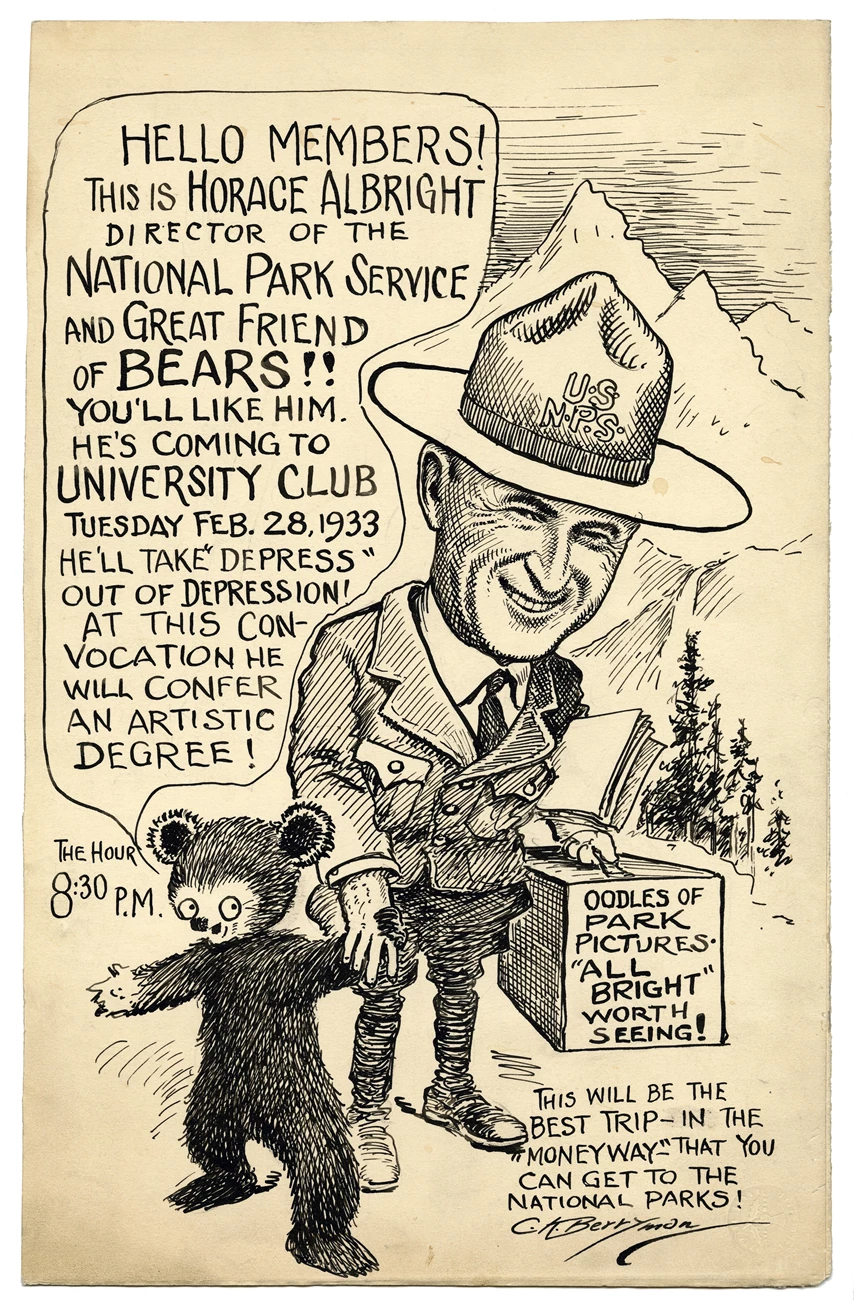Last updated: March 11, 2023
Article
50 Nifty Finds #15: The Art of Politics
Political cartoons have long been a way for artists and their editors to bring attention to important social issues or political corruption and to support meaningful causes. The NPS History Collection includes drawings by some of the most influential cartoonists from the 1920s to the 1950s, including Ralph O. Yardley, Frank Kettlewell, C.K. Berryman, and others. Their support publicized the National Park Service (NPS) while helping build political support to protect park resources from commercial interests.
Ralph O. Yardley
Ralph Oswald Yardley was born September 2, 1878, in Stockton, California. He grew up there with his two siblings and parents John and Caroline. He later recalled, “At a very early age I began itching for something and I’ve been scratching with pen, pencil, and brush ever since.” Yardley studied at the Mark Hopkins Institute of Art in San Francisco, California, around 1895. He also attended the Partington Pen and Ink School in San Francisco.
He started his newspaper career at the San Francisco Examiner. In 1900 he began working as the staff artist and cartoonist for the Honolulu Advertiser, where he sometimes embellished his drawings with his poems. He returned to California in 1902 after his father became ill and worked for the San Francisco Chronicle. In 1903 the San Francisco Bulletin began publishing his comic strip “The Adventures of Ping and Pong.” By 1905 he was working as an illustrator for the New York Globe. He returned to San Francisco to become manager of the art department of the San Francisco Call. For several years he did freelance work creating covers for Harper’s, Leslie’s, and other national magazines. When Yardley began his career he illustrated news stories, features, and editorials. He often created a rough sketch in the field but also took photographs to draw from later. At the time it was impossible to reproduce a photograph in a newspaper any other way.
By 1910 Yardley was working as an artist in Manhattan. He returned to California again sometime before 1918 and worked as a self-employed artist. During World War I, he created illustrations for the liberty loan organization, headquartered in San Francisco. In April 1919 he married Carmen Glauch. They went on to have two daughters. Also in 1919 he opened a commercial studio. One of his studio jobs for the next three years was to provide a daily editorial cartoon for the San Francisco Bulletin.
In 1922 the Yardleys returned to his hometown when he became the first artist at the Stockton Record. He was already a famous artist and cartoonist when the paper hired him. Yardley spent the next 30 years as an editorial cartoonist, sports cartoonist, artist, and photographer with the Record. Yardley drew his last regular editorial cartoon for the paper on July 12, 1952. He died on December 6, 1961, aged 83.
The NPS History Collection includes 13 Yardley cartoons drawn between 1923 and 1928. Many of them address the need to protect park resources from loggers or other private interests. His August 21, 1923, cartoon was published as "Mr. Mather's Suggestion" with the subtitle "Stockton Tree Lovers Should Save Timber Along Big Oak Flat Road." The top panel features people proclaiming that they have saved individual trees while a large axe labeled "Lumber Interests" looms. In the bottom panel, the trees along the road to Yosemite National Park have been clear cut and only stumps remain.
The cartoon and its accompanying editorial refer to a challenge given to the city of Stockton by NPS Director Stephen T. Mather. He encouraged residents to protect the trees growing along the Big Oak Flat Road to Yosemite from timber interests. The city, praised for planting trees along the highway, is admonished to protect existing magnificent trees that couldn’t be replaced for generations. Mather had already lost a battle that ended with timber cutting along the highway between Wawona and Mariposa Grove of Big Trees in Yosemite. This cartoon was a call to action to prevent it from happening again.

Yardley also drew cartoons representing NPS conferences in 1925 and 1928. His October 10, 1925, "Homeward Bound" cartoon is subtitled "National park superintendents and their 'boss' getting back to the job full of pep 'n everything." It depicts a line of cars leaving Mesa Verde National Park, where the conference was held. The last car is stopped at a filling station where NPS Director Stephen T. Mather fuels up the car with "pep" and says, "Now let's go." The luggage on the back of the car includes plans, budgets, and stimulus labels. The 1923 Mesa Verde conference was the first one where superintendents and their wives travel to by car instead of by train. Their car caravans stopped at national parks and monuments along the way. Superintendents familiarized themselves with other parks, the country surrounding them, and general road conditions on the way to and from the conference.
Yardley's July 31, 1926, cartoon "Without a Gear Shift" highlights the opening of the all-year road to Yosemite National Park. Cars labeled for spring, summer, autumn, and winter join a line of traffic driving up a road through a mountain pass. A sign on the sign of the road declares the all-year road is open.

A Faithful Friend to Parks
You can’t discuss Yardley’s national park cartoons without paying tribute to managing editor G. Elmer Reynolds. He lent the support of the Stockton Record to national parks and the NPS. For years he ran a full page dedicated to national parks every Saturday, including photographs and maps submitted by park superintendents. He heavily influenced Yardley’s national park drawings as well. Yardley’s artistic talents were put to good use by Reynolds, the idea man for most of the cartoons. After Reynolds’ unexpected death in the office on July 21, 1928, the paper described how workers completed his last edition noting, “The cartoon that had been drawn at his direction boosting his pet hobby—the people’s parks—is completed. It is particularly appropriate that this should be the subject of the last Yardley drawing that he should plan.” Reynolds’ support for the NPS was widely acknowledged. His loss was felt by “almost the entire personnel of the National Parks [sic] Service throughout the nation.”
A July 23, 1928, article described Reynolds’ influence and support, noting:
In the matter of the Record’s championship of the national parks, Mr. Reynolds was allowed to have his way on faith and loyalty alone. It cost money, loads of it, to get the photographs, make the cuts, and give up the space to making the Record’s continuous campaign for the “people’s playgrounds.” It seemed that it was out of place of a newspaper with the limitations and handicaps of the Record to spend so much of its resources in a work that was nationwide in its scope and beyond its own news constituency. But Elmer’s love of the out o’ doors was so evident and his desire to campaign for park and forest protection and betterment so insistent that Mr. Martin [the paper’s publisher] yielded, and when the work of the Record’s Out o’ Doors section Saturday after Saturday brought Mr. Reynolds the personal recognition and praise of the Park Service from Stephen T. Mather in Washington down to the humblest ranger, Elmer was happy because of the prestige it brought the Record.
Upon hearing of Reynolds’ death, Director Mather and Horace M. Albright, associate field director and superintendent at Yellowstone National Park, sent a telegram to Irving Martin. It read:
Elmer’s death terrible shock to us. Please extend our deepest sympathy to his relatives and to his associates on the Record. The National Parks have lost their most faithful friend and we have lost one of our most beloved associates in a great public work. Yosemite flags are ordered to fly at half-mast in his honor and rangers will attend funeral in uniform.
Yosemite Naturalist Charles P. Russell credited Reynolds as the “prime mover” behind the park’s Nature Notes publication and the “Yosemite Nature Notes” column in the newspaper. It was only through a partnership with the Stockton Record that the park’s newsletter was printed. Russell called him a “soldier, a general in fact, in the cause of conservation” and observed, “We had come to look upon him as an integral part of the National Park Service.”
Frank "KET" Kettlewell
Benjamin Franklin Kettlewell, Jr. was born on December 5, 1889, in St. Helena, California. He graduated from the local high school. He first went to San Francisco in 1906, arriving with relief supplies for victims of the earthquake and fire. He decided to stay in the city with his grandfather while attending Hopkins Art School.
Kettlewell began working for the Oakland Tribune in 1912. He married Beatrice Jackson on January 15, 1913, in St. Helena. By 1917 Kettlewell was head of the paper’s art room. In 1948 the US Post Office Department used his drawing of Sutter’s Mill as the design for a stamp commemorating the discovery of gold in California. Kettlewell was not only one of the Bay Area’s leading editorial cartoonists but also a photographer, painter, amateur astronomer, metalworker, woodworker, and map maker. He drew maps to illustrate news stories and travel articles. The Oakland Tribune published a book of his road maps featuring the early days of the automobile. His map showing how San Francisco Bay was shrinking was adopted as a symbol of the Save the Bay Association. He died on June 11, 1969, in Oakland, California, from a heart attack following surgery for appendicitis. He was 79 years old.
Kettlewell signed his drawings KET. He usually included a small bird in his drawings; sometimes it would add commentary to the cartoon. His drawings often featured anthropomorphized objects and natural features of parks, such as geysers, volcanoes, and Yosemite's El Capitan and Half Dome.
The NPS History Collection includes 15 cartoons drawn by Kettlewell in the 1920s to 1930. His "Yosemite Timber" drawing features Uncle Sam wielding a "Congressional Bills" hammer to pound in a sign that reads "Belongs to Public. Private Interests Keep Out." Trees marked "Yosemite Timber," El Capitan and Half Dome are seen in the background. A disgruntled-looking saw blade and axe walk away as one of Kettlewell's birds says, "On your way." His January 25, 1930, cartoon "Stephen T. Mather's Monument," featuring "US National Parks" on a tree trunk, was published three days after the first NPS director's death.

Six of our KET cartoons feature park visitation as themes. One 1927 drawing features a smiling Mount Lassen spewing out a cloud that says "Visit the National Parks this summer" while other parks and features cheer and clap. A smiling Mount Rainier throws up its hands and says "Atta Boy Lassen" while a Yellowstone geyser says, "Ditto." A smiling El Capitan claps its hands as a mountain from Sequoia National Park raises its arms skyward. Next to a sign that says "Big Trees" is a celebratory tunnel tree figure.
An image of an iconic tree tunnel and marked "Yosemite National Park" depicts a long stream of cars entering the park, heading towards Half Dome and El Capitan in the distance. Imposed over the cars is "460,610 visitors this year." Another cartoon features an audience in front of a stage marked "California's National Parks and Monuments." Sketches of Lassen Volcano, Half Dome, Pinnacles rocks, and trees from Sequoia and General Grant parks and Muir Woods are marked by signs. Imposed over the audience is "755,000 visitors this year." In the last example, a smiling face on Half Dome looks at outraged or sad characters of a Yellowstone National Park geyser, Glacier mountain, Lassie volcano, and Grand Canyon which didn't have as much visitation as Yosemite. The text above the foreground, which features campgrounds and a line of automobiles reads, "11,639 people visited Yosemite over the Fourth. 81,303 visitors to date this season."

C.K. Berryman
Clifford K. Berryman was born on April 2, 1869, in Clifton, Kentucky. He moved to Washington, DC, in 1889 to work as an illustrator with the US Patent Office. In 1889 the Washington Post hired him as a political cartoonist. In 1907 he was hired by the Evening Star. Berryman remained with that paper for the next 42 years. He was awarded a Pulitzer Prize for Editorial Cartooning in 1943. Berryman married Kate Geddes Durfee on July 5, 1893, and they had three children. His son James T. Berryman would also become a Pulitzer Prize-winning cartoonist. C.K. Berryman died in 1949.
Berryman was Washington's best known and most-admired graphic commentator on politics in the early 1900s. He is also credited with introducing the teddy bear into American culture after President Theodore Roosevelt famously refused to shoot an old, haggard bear during a hunting trip. Berryman changed the old bear into a cute, cuddly "teddy bear." The "Berryman bear" was a common symbol in his cartoons long after Roosevelt left office.
The National Archives has a collection of over 2,400 of his pen-and-ink drawings. The cartoons comment on Washington politics, congressional issues, presidential elections, and both world wars. His work is also found at the Library of Congress, DC Public Library, George Washington University Library, and many other collections.
The NPS History Collection has two C.K. Berryman cartoons. The first was published in the Evening Star in 1927. Titled “In the Yellowstone,” it features President Calvin Coolidge dressed in a suit and boater hat carrying a fishing pole and an empty tin can. He is standing among spewing geysers with clouds of hot air and steam. The text reads, “And I thought I was getting away from all suggestions of Congress.”

The second features NPS Director Horace M. Albright wearing his NPS uniform. He holds the paw of a “Berryman bear” in one hand. In the other he carries some papers and his cased lantern slide projector (which is also part of the NPS History Collection). The end of the case is marked “Oodles of park pictures. ‘All Bright.’ Worth Seeing!” The bear has a speech bubble that reads, “Hello Members! This is Horace Albright Director of the National Park Service and great friend of Bears! You’ll like him. He’s coming to University Club Tuesday Feb. 28, 1933. He’ll take “depress” out of Depression! At his Convocation he will confer an artistic degree!” The hour is noted as 8:30 pm. Above C.K. Berryman’s signature in the bottom right corner it reads “This will be the best trip—in the ‘moneyway’—that you can get to the national parks!”
Berryman often gave away his original cartoons to politicians or his other subjects who requested them. It’s believed he gave this one to Albright following his presentation at the University Club. He drew similar announcements for other guests and events at the club. Albright resigned from the NPS on August 9, 1933, not long after this cartoon was drawn.

Other Artists
The NPS History Collection includes a smaller number of cartoons created by other artists from the late 1920s to the 1950s. Two are single panel comics featuring Yellowstone National Park in 1928 and 1934 created by Gaar Williams for the Chicago Tribune. Three political cartoons by Saturday Evening Post artist Herbert Johnson are also included. One Sequoia-related cartoon was drawn by Hy Gage, whose work was published in the Philadelphia Press and Philadelphia Evening Telegram. A couple of the cartoons in the collection were given as gifts to NPS directors. John T. McCutcheon inscribed his "Commercializing Our National Parks" four-panel political cartoon to his friend Stephen T. Mather. Jim Berryman, Pulitzer Prize-winning son of C.K. Berryman, gave one of his national park cartoons to NPS Director Conrad L. Wirth in 1955.
Sources:
--. (1895, August 22). “Art in Studios Again.” The San Francisco Call (San Francisco, California), p. 8.
--. (1905, December 28). “Yardley Turns Poet.” The Hawaiian Star (Honolulu, Hawaii), p. 6., July 21
--. (1922, January 14). “Ralph Yardley on the Record.” Stockton Evening and Sunday Record (Stockton, California), p. 16.
--. (1928, July 21). “At Height of His Usefulness.” Stockton Evening and Sunday Record (Stockton, California), p. 32.
--. (1928, July 28). “Yosemite Valley Flags Half Mast.” Stockton Evening and Sunday Record (Stockton, California), p. 11.
--. (1928, July 28). “Messages of Sympathy.” Stockton Evening and Sunday Record (Stockton, California), p. 11.
--. (1952, July 11). “Good Wishes to Ralph O. Yardley.” Stockton Evening and Sunday Record (Stockton, California), p. 40.
--. (1961, December 6). “Ralph Yardley Succumbs.” Stockton Evening and Sunday Record (Stockton, California), p. 1-2.
--. (1961, December 7). “Ralph O. Yardley: Newspaperman.” Stockton Evening and Sunday Record (Stockton, California), p. 48.
--. (1969, June 12). “Frank Kettlewell.” Oakland Tribune (Oakland, California).
National Park Service. (1925). "Minutes of the Eigth National Park Conference Held in Mesa Verde, Colorado, October 1 to 5, Inclusive." NPS History Collection (HFCA 1645), Harpers Ferry, WV.
Peterson, L.V. (1928, July 23). “Sacredly Tender Ties Broken in the Passing of G. Elmer Reynolds.” Stockton Evening and Sunday Record (Stockton, California), p. 11.
Michael E. Ruane, Michael E. (2008, February 3). "Caricaturing Campaigns." Washington Post, accessed at https://www.washingtonpost.com/wp-dyn/content/article/2008/02/02/AR2008020202086.html
Russell, C.P. (1928, July 28). “A Soldier Passes.” Stockton Evening and Sunday Record (Stockton, California), p. 27.
Shankland, Robert. (1970). Steve Mather of the National Parks. New York: Alfred A. Knopf.
